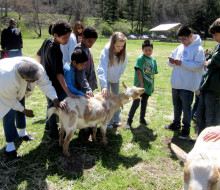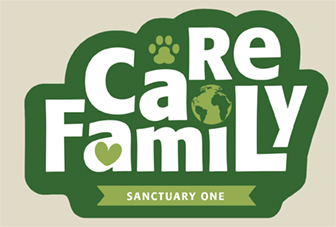
Online Lessons for Educators
In the early months of the COVID shutdown Sanctuary One’s education staff put together online lessons for parents as a way to help keep young minds busy and help parents with free supplemental projects. As online education continues, we’d like to share these lessons, now connected with education standards, with teachers.
We ask that you fill out a form for each lesson you use to help us provide information to our grant foundation supporters. With our continued foundation supporters we will be able to continue creating more free resources for educators. This will also allow us to learn from you, in the education field, and ensure we can provide the best possible resources for you as we create more lessons and virtual field trips.
Available Lessons:
Animals of the Night Lesson Plan:
Want to learn more about the animals that roam the night? In this lesson, your students/kiddos will practice critical thinking, writing, drawing, and discover new terminology. This lesson is great for students 7-10 years old and the video is fun for all ages. For children under 7 this lesson can be modified with an adult reading the questions and helping write their child’s answers. For this activity, you will need a pencil, access to the internet, and coloring supplies.
- 4-LS-1 Construct an argument that plants and animals have internal and external structures that function to support survival, behavior, and reproduction.
- 1-LS-1 Use materials to design a solution to a human problem by mimicking how animals/plants use their external parts to help them survive, grow, and meet their needs.
- LS1.D Information Processing
Learn about the different types of feet we have here at Sanctuary One. Kids will learn about different feet structures, functions, and adaptations in this fun and interactive worksheet. This activity is great for 4th-5th grade with younger children needing parental assistance. For this activity, you will only need a writing utensil.
- 4-LS-1 Construct an argument that plants and animals have internal and external structures that function to support survival, behavior, and reproduction.
In this activity, students will learn about what animals need from a habitat. They will use writing, drawing, and games to help them learn these components. This activity is suitable for grades 1st-4th with younger students needing adult help. For this activity you will need a writing utensil, drawing supplies, and room to move around.
- K-LS1-1 Use observations to describe patterns of what plants and animals need (including humans) need to survive.
- VA.2.CR2.K Create art that represents natural and constructed environments.
Say What?! Pet Communication Lesson Plan
Students will learn the three ways organisms communicate. They will then use charts and guided questions to help learn what their own pets are saying. This activity is designed for students in grades 3rd-5th younger students will need parental assistance. For this activity, you will need a writing utensil and a pet to observe.
- 4-LS-1 Construct an argument that plants and animals have internal and external structures that function to support survival, behavior, and reproduction.
- 1.W.7 With guidance and support, participate in shared research and writing projects.
In this activity students will learn about pigs and what makes them such special creatures. They will get to watch fun videos and learn interesting facts. At the end of the activity they will use what they learned to help practice their creative writing skills or artistic skills. Once done here join us on the farm this summer to meet the pigs in person. This activity is suitable for students in grades 2nd-5th with younger students needing parental assistance. For this lesson you will need a pencil and access to the internet.
- 4-LS-1 Construct an argument that plants and animals have internal and external structures that function to support survival, behavior, and reproduction.
- 3.W.3 Write narratives to develop real or imagined experiences or events using effective techniques, descriptive details, and clear event sequences.
Join us in learning about the fantastic insect the ladybug. In this activity, your students will be introduced to the life cycle of the ladybug and their importance. With a fun art activity, they will learn about insect anatomy. This activity is suitable for grades 2nd-5th with younger students needing parental assistance. For this activity, you need a writing utensil and art supplies.
- 3-LS1-1 Develop models to describe that organisms have unique and diverse life cycles but all have in common birth, growth, reproduction, and death.
- LS1.B Growth and Development of Organisms
Life in a Compost activity introduces students to the world of composting and the organisms that make the process function. This activity is suitable for students in 5th-8th grade with younger students may need assistance. For this activity, you need a writing utensil and for an optional activity supplies to set up a compost.
- 5-LS2-1 Develop a model to describe the movement of matter among plants, animals, decomposers, and the environment.
- LS2.A Interdependent relationships in ecosystems
Studying Nature with our Food Part 1
Collect mushroom spore prints at home and learn about the world of mushrooms. This activity can be done with any mushroom you buy at the store or find in your yard that have gills. Materials that you will need are a couple of mushrooms, white sheet of paper, and a bowl or cup. This lesson is designed for students 3rd-5th grade.
- 3-LS1-1 Develop models to describe that organisms have unique and diverse life cycles but all have in common birth, growth, reproduction, and death.
- LS1.B Growth and Development of Organisms.
Studying Nature with our Food Part 2
This activity explores the plants that are on our plate. Your students will learn about the different plant parts they are eating and the function of those parts. Learning more about what we eat is important in making healthy eating choices. Keep the learning going after the activity quiz your kids when eating, at the grocery store or in your garden. This activity is designed for students in 1st – 4th grade, younger students will need parental help. For this activity you need a pencil and access to the internet.
- 1-LS-1 Use materials to design a solution to a human problem by mimicking how animals/plants use their external parts to help them survive, grow, and meet their needs.
- LS1A Structure and Function
Studying Nature with our Food Part 3
In this hands-on activity, you are going to put that celery that has been sitting in your vegetable drawer to good use. In the first experiment, students will get to study what role stalks play. In the second experiment, they will get to test a hypothesis and grow their own food. This activity is great for students in grades 2nd-5th with younger kids needing parental assistance. Materials needed for this activity are a piece of celery, two small cups with water, and two different colors of food dye.
- 1-LS-1 Use materials to design a solution to a human problem by mimicking how animals/plants use their external parts to help them survive, grow, and meet their needs.


